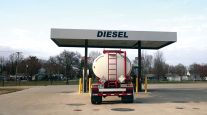Diesel Drops 10.1¢ to $4.50 a Gallon
By Frederick Kiel, Staff Reporter
This story appears in the Aug. 11 print edition of Transport Topics.
The cost of retail diesel fell another 10.1 cents last week to $4.502 a gallon, the third-straight weekly decline in the national average that has cut 26.2 cents from trucking’s main fuel, the U.S. Department of Energy said.
Gasoline also dropped 7.5 cents to $3.88 a gallon, DOE reported Aug. 4 after its survey of fueling stations.
“The pure and simple answer for the drop in retail fuel prices has been the falling cost of crude oil,” Neil Gamson, an economist at DOE’s Energy Information Administration, told Transport Topics.
Since closing at $145.18 a barrel on the New York Mercantile Exchange on July 14 — just short of the latest record of $145.29 on July 3 — crude has fallen steadily, closing at $118.75 on Aug. 5.
Diesel reached its high of $4.764 on July 14, before starting its descent. Gasoline topped out at $4.114 a gallon on July 7 and has fallen a total of 23.4 cents over four weeks, DOE figures show.
The price of both diesel and gasoline declined in every region in the country last week.
Despite the recent drops, diesel is $1.604 a gallon more expensive than just a year earlier, and gasoline is $1.042 more expensive. For truckers that equates to $1.2 billion more for diesel and $297 million more for gasoline each week based on average burn rates of 752 million gallons of diesel and 285 million gallons of gasoline.
“Americans have been doing a lot less driving because of the price surge, the weak economy has less freight moving and that lower consumption brought crude and then retail fuel costs down,” Gamson said.
Falling pump prices, though small in relation to the run-up in diesel prices over the past year, are bringing some benefits to truckers.
“The price cut has helped the profit margins of our members, and maybe they can recoup some of the money they overpaid for fuel on the way up, now that it’s on the way down,” David Owen, president of the National Association of Small Trucking Companies, told Transport Topics.
Owen said that NASTC members, if they fuel up at 850 participating truck stops, pay lower diesel prices.
Todd Spencer, executive vice president of the Owner-Operator Independent Drivers Association, was more cautious.
“I suspect that we have not heard any big ‘hip-hip-hurrahs’ about falling diesel prices, but the tone of members calling our office is somewhat more positive than it has been,” Spencer told TT. “If you follow the energy headlines, there is reason for cautious optimism that the speculative bubble that played a role in jacking up fuel prices is now on the downside.”
Tancred Lidderdale, an EIA senior economist, said that U.S. consumption of petroleum has declined for each of the past 12 months — August 2007 through July — compared with the corresponding months of the previous year.
“That’s the first time this has happened since 1990-1991, when we were in a recession,” Lidderdale told TT.
“Demand is not falling as fast for diesel . . . [as] for gasoline, but overall, people are driving less, and the market is working just as we thought it would,” said Noel Perry, principal of forecasting firm Transport Fundamentals.




